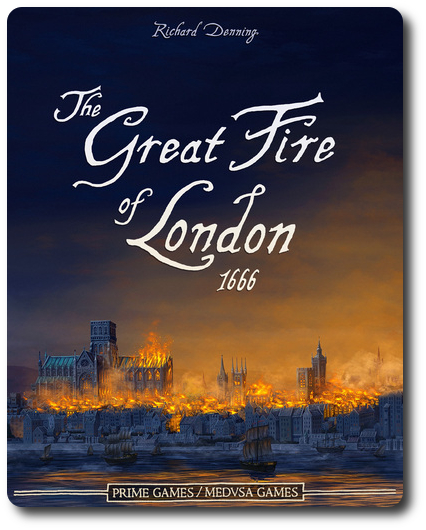
The Basics:
- For ages 12 and up
- For 3 to 6 players
- About 1.5 hours to complete (more depending on number of players)
Geek Skills:
- Counting & Math
- Logical & Critical Decision Making
- Pattern/Color Matching
- Strategy & Tactics
- Risk vs. Reward
- Hand/Resource Management
- Worker Placement & Area Control
Learning Curve:
- Child – Moderate
- Adult – Easy
Theme & Narrative:
- On September 2, 1666, a careless baker accidentally sets fire to his home and the city – time to save London, but more importantly, your property!
Endorsements:
- Gamer Geek approved!
- Parent Geek rejected!
- Child Geek rejected!
Overview
It was a simple and silly mistake that lead to the Great Fire of London in 1666. A baker carelessly left his oven fires burning and unattended. The flames escaped their coals and caught the baker’s house on fire. The fire spread quickly and soon engulfed Pudding Lane. The alarm was raised and the news spread quickly. When the ill tidings reached your ears, you quickly moved your family to safety and then focused on more pressing matters. Specifically, saving as much of your property as possible and doing it in a way that could win you favor in Londoners’ eyes. Truly, the ambitious make use of all opportunities.
The Great Fire of London 1666 (1st edition), by Prime Games and Medusa Games, is comprised of 1 large and detailed game board that represents the city of London, 120 Houses (in 6 different colors, 20 per player), 12 player pawns (in 6 different colors, 2 per player), 6 Player Color cards, 24 Objective cards, 60 Fire Movement cards, 20 tokens (10 Demolition Charges, 6 Double Move, and 4 One Victory Point), 100 Fire cones (red), 6 Trained Band cones (black), 6 Fire Stack cards, 1 cloth bag, and 1 Hero of London card. All of the game bits are very well made and the board illustration is superb.

Example of what bits are included in the game
Game Set Up
Note: Prior to your initial game, you will be required to apply stickers to the 20 tokens. This took us all of 5 minutes, but you should still plan accordingly before you suggest playing it with family and friends.
To set up the game, first unfold and place the game board in the middle of the playing area. The game board is slightly larger than average, needing more space. In the Pudding Lane location (red on the game board), place 25 Fire cones. This represents the initial strength of the blaze that will burn London to the ground. The remaining Fire cones can be left in the box until needed later in the game.
Take and shuffle the 50 Fire Move cards and deal 5 per player, face-down. This creates the player’s starting hand and should be kept hidden from the other players. If any player receives 5 cards that show the same fire movement direction, they are dealt another 5 cards with the initial 5 cards shuffled back in the deck.
The number of cards on the Fire Stack is dependent on the number of player. Refer to the game rules for specific requirements. Once the proper number of Fire Stack cards are selected, place the first Fire Stack card (noted with the letter “A”) face-up and deal out a number of Fire Move cards as determined by the number of players in the game. These cards are dealt face-down. Once that number of cards is dealt, the next Fire Stack card is placed on top, face-up, and additional Fire Move cards are dealt on top of that, face-down. This continues until all the Fire Stack cards have been placed and cards dealt on top. This deck should not be reshuffled and is placed, face down on the game board.
Now put 5 Houses of each color in the cloth bag (for a total of 30 Houses) and mix them up. Starting with the orange region on the game board, blindly draw and then place 1 House per icon on each of the districts. Note that some districts in a region will have many more houses than others. Continue to do this until the entire region has been populated with Houses and then move on to the next region by first selecting and placing in the cloth bag another 5 Houses of each color. Houses are only placed on those regions that contain a House icon. When completed, all 4 regions will be populated with Houses. Note that it is possible and completely OK to have more House colors than there are players.
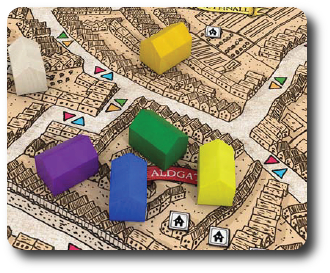
Example of random House placement in a district
Shuffle the 6 color cards and randomly deal one to each player. The players are now given 2 players pawns that match the card color. Any unused color cards and pawns are discarded and not used for the duration of the game.
Separate the Objective cards into three different decks, as indicated by the roman numeral on the card’s back. Shuffle each of these decks and hand 1 card per deck to each player, face-down. These are special goals and should be kept secret from the other players. Any unused Objective cards are discarded and not used for the duration of the game.
Take and place face-down the 20 tokens. Shuffle these around to ensure they are well mixed. Place one token, face-down, on each district on the game board with a yellow label.
Depending on the number of players, the Trained Band cones are now placed in predetermined spots on the game board and a specific number are given to each player to place. Now select player turn order using whatever method works best. Starting with the first player, one of their Trained Band cones are placed in any district except the green region that surrounds Pudding Lane and in Pudding Lane itself. More than one Trained Band can occupy the same space at the same time. Continue until all Trained Bands are placed.
Once completed, the first player now places one of their two player pawns using the same rules as the Trained Band placement, including not being able to place a player pawn in any grassed areas. More than one player pawn can occupy the same district at the same time. Continue until all player pawns are placed.
Lastly, place the Hero of London card to one side of the board. You are now ready to play!
Burn, Baby, Burn!
Note: The rules of moving the fire and containing it by using the Trained Bands and Demolition Charges are very detailed in the rules. Detailed and lengthy. Rather than duplicate the entire rules, we will summarize the player’s turn here and ask that you kindly refer to the game rules for specifics.
Players will take turns, completing three phases per turn. Once completed, the next player goes, repeating the same three phases. The three phases are as follows:
Phase 1: Expand the Fire
The player plays one of their Fire Movement cards from their hand. This indicates where the fire is traveling to and will eventually stop, but does not show the specific direction the fire must burn before getting there. Each Fire card shows a colored arrow and a compass direction indicating the last move the player must make with a Fire cone. The player now selects a Fire cone and begins to move it through the city, following the rules of Fire movement. The fire is welcome to move through any district as long as it is connected with arrows or a four-way cross symbol. The player’s final move with the Fire cone must be in the direction indicated by the Fire Movement card. If the player has a Double Move token, they may now discard it to move another Fire cone using the same or a different path and ending the movement of the Fire cone on the same or different district.
If a Fire cone moves into a new district with Houses, all of those Houses are removed and placed on the Victory Point track located on the game board. Each house is placed on the currently highest showing numerical value in the row that matches the House color. In this way, the burned houses keep track of the current number of victory points each player has, with that value being reduced each time a House of their color burns.
If a Fire cone moves into a district with a Trained Band cone that is not currently containing another Fire cone, the Trained Band cone is placed on top of the Fire cone and there is no additional movement for that specific Fire cone. If a Fire cone moves into a district with a Trained band cone that is not currently containing another Fire cone and has Houses, the Trained Band cone is placed on top of the Fire cone and the Houses are saved (not removed).
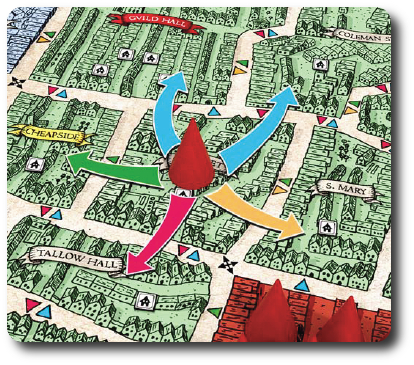
Example of Fire cone movement
If the number of Trained Band cones in a district is equal to or higher than the number of Fire cones, then the fire is contained in that area and cannot spread from or through that specific district. If, however, that should ever change, the fire is considered out of control (again) and can burn wherever it likes, including traveling through and starting from that district.
Additionally, fire cannot spread through or land on the grassed areas in the city. Any Fire cone that lands in a new area with a token is claimed by the player and kept secret until used. Any Double Move tokens can be used as soon as they are claimed. Victory Point tokens are simply kept until the end of the game for scoring purposes. The Demolition Charges token can be used on Phase 2.
Phase 2: Fight the Fire
The player now has three actions they can take, each taking 1 action point to complete, with a player having 4 action points total to spend. Each action can be repeated as long as the player has action points.
- Move the player’s pawn 1 or more spaces at a cost of 1 point per space moved. Movement can be from any district to any adjacent district and can move through grassed areas, but can never enter Pudding Lane.
- Move a Trained Band cone 1 or more spaces at a cost of 1 point per space moved, using the same rules as player pawn movement. There are only two exceptions. If the Trained Band enters a district that has a Fire cone, it must stop and fight that fire, being placed on top of the Fire cone. Additionally, any Trained Band fighting a fire cannot move.
- Put out a fire, which is only possible if the number of Trained Bands is equal to or greater than the number of Fire cones in that district and the player pawn is located in the same district. For 1 point each, a Fire cone can be removed from that district. These Fire cones are placed in front of the player and count as 1 victory point each at the end of the game. The first player to collect 3 Fire cones takes the Hero of London card. If another player has more Fire cones in front of them than the Hero of London, they now claim the card.
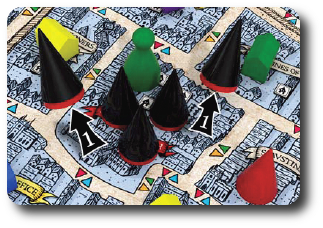
Example of Trained Band fighting a blaze
If a player has a Demolition Charge token, they can use it on any district that is adjacent to another district that is on fire, but must not contain any Fire cones itself. A Trained Band cone must be located in the district to be exploded. Once exploded, remove all the Houses in that space and place them on the Victory Point track as you would if they were burned. Any face-down tokens are removed from the game. Place the Demolition Charge face-up in that district. This district is now a fire break and Fire cones cannot pass through or end their movement in this district for the duration of the game. Exploding a Demolition charge is a free action (does not cost an action point).
Phase 3: Draw a Fire Card
The player now draws a Fire card from the deck and adds it to their hand. If a Fire Stack card is revealed when the card is drawn (will be face-up on the deck for all to see), the fire intensifies! Three additional Fire cones are added to any district (excluding Pudding Lane, which is a total lost cause) with a non-contained Fire cone, as long as the total number of Fire cones in that district does not exceed the number of House icons, plus 2. Any non-placed cones can be added to Pudding Lane. Once the fire intensifies, the Fire Stack card is discarded.
If at anytime there are no Fire cones in Pudding Lane, simply add more.
This ends the player’s turn.
Endgame and Scoring
As soon as the last Fire Stack card is revealed and the fire intensifies, all players now have one last turn. For this final turn, the last phase is skipped. Victory points are then calculated. By default, the player has a number of victory points equal to what is shown on the Victory Point track, but gain points for the following:
- +1 victory point for every Fire cone they have claimed
- +X victory points for any hidden Objective districts that survived, where “X” is the point value of that Objective card
- +1 victory point for every Victory Point token they claimed
- +2 victory points for holding the Hero of London card
The player with the most victory points wins the game. In the event of a tie, the player who put out the most fires wins.
Game Variants
There are two game variants that can be used. These are as follows:
- Hidden Colors: Keep the 6 color cards that represent which pawn belongs to a player hidden when dealt. Players then randomly select and place two player pawns instead of being given two of the same color. When moving player pawns during Phase 2, any player pawn can be used. This will keep the other player’s guessing what color belongs to each player and how many victory points each player has. Reveal the player’s color only at the end of the game during scoring.
- More Destruction: After a final Fire Stack card is revealed and the fire intensifies, each player has two final turns instead of one.
To learn more about The Great Fire of London 1666 and read the complete rules, see the game’s web site.
Prediction
This game looks intense, but not unmanageable. Nor does it appear to be beyond my 7-year-old’s abilities. The game length is a concern, as is the chaotic and ruthless nature of the fire. This will most likely be a game that tries the player’s patience and challenges their thinking. Such games are great for Gamer Geeks, but can be too much for Parent Geeks who are looking for a more casual game, and can be downright exhausting for Child Geeks. It’ll be interesting to see how this game plays out with the three test groups.
Teaching the game is surprisingly simply, when you consider just how big the game is. Each phase is very specific and the actions to be taken are clear. The only problem I had was demonstrating the fire movement. This can be tricky and at times it is not clear where a Fire cone can be placed. The fire priority that governs where a Fire cone can be placed really needs to be spelled out as a player aid for quick reference, but the logic behind that Fire cone movement is fairly straight forward, just not easily translated to the board. We opted to simply tackle any questions as they came up rather than play the “what if game”.
As I taught my little geek the game, he was noticeably overwhelmed. He still has flashbacks to our game plays of Belfort and didn’t want to get involved with a game that would take all day or make him angry or frustrated. I told him he was welcome to take as many breaks as he wanted and there was no time limit. This seemed to calm him and we continued. After several demonstrations, we were ready to play. As I reset the board for our 3-player game, I asked him his thoughts on the game so far.
“This looks hard.” ~ Liam (age 7)
Yep, that’s all he said. He then frowned and his facial expression went grim. Hard to say if that is the look of determination or of stoic acceptance. Either way, let’s play the game and see if it is a winner or burns lots of bridges.
Final Word
I should make it clear that my little geek could play the game and play it well. He understood the objective, how the fire moved through the city, and did a wonderful job directly the flames towards homes that he did not own. What ultimately did him in and made him leave the table was the time it took to play the game and the ever shifting flames. He was, if you’ll excuse the pun, burnt out. The constant need to move the flames, fight fires, and only a turn later see his property burn, eventually got old. He lasted 30 minutes, asked for a break, and never returned to the table. When I asked him later what he thought of the game, he said it was neat but just too much for him to handle. As such, we cannot recommend this game for any player younger than already stated by the game publisher.
Parent Geeks felt more or less the same way. They also enjoyed it, but the constant need to manage the board and see the flames jump to what was supposedly a protected part of the city became frustrating. The prospect of winning became even less likely as the game continued and house after house were burned to the ground. The worst part, according to one Parent Geek, was seeing the player victory points disappear. The fire proved to be too much for them and the game was found to be too involved for casual play with friends and family. Non-gamers, as you probably guessed, were intimidated beyond belief and suggested that playing this game was one of the most stressful things you could do around the kitchen table.
Gamer Geeks greatly enjoyed the burn. The game is exceptionally challenging without being unmanageable. The players must be on their toes at all times, constantly reevaluate the board, and make hard choices. The only resource in the game that is in abundance is the fire and it is relentless. Houses quickly burn, victory points are quickly lost, and the game becomes an exercise in survival. It became clear to the Gamer Geeks that this game was about stamina, strategy, and tactics that brutally punished a player who didn’t pay attention and carefully think out their plan. They loved it.
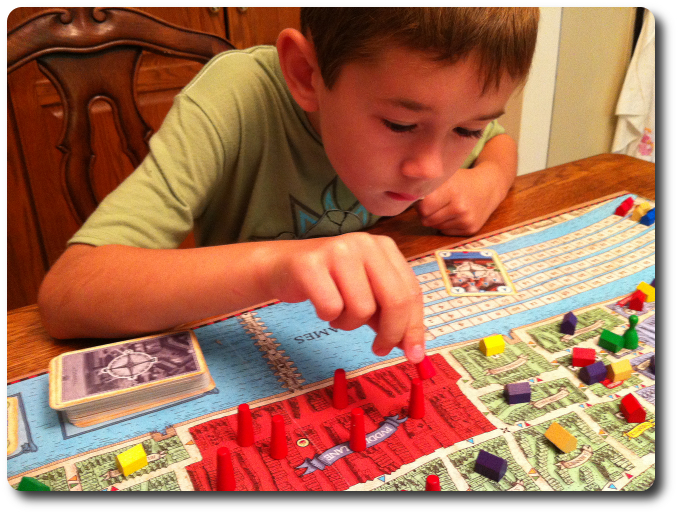
My little geek considers the path he wants the flame to take while I nervously await for the inevitable destruction
Gamer Geeks, this is a challenging and engaging game. You’ll need to make tough choices and should expect to lose points. If it makes you feel any better, everyone will lose points. The goal is to lose the least amount, meaning you’ll need to play as strong as possibly defensively and offensively. Aggressively fight the fires and shrewdly redirect the flames towards parts of the city where your loss is less than your opponents. This is a game where your strategy and tactic skills will be heavily tested. Expect moments of all-consuming frustration, exuberant jubilation, and a real good time.
Parent Geeks, unless your definition of “casual” is over an hour of intense focus, constant revaluation, and a lot of self-doubt, you might want to consider a different game. The Great Fire of London 1666 is an unforgiving and relentless property eating monster. It will roll over everything in its path and there is simply not enough Trained Bands to fight fires that rage all across the city. The game is frustrating, nail-biting, and intense. I know I make it sound like a real fire, and it might as well be. Much like flame and heat, the game grows in intensity as it builds and leaves nothing but smoldering ruin behind. But in this case, since it’s a board game, the only thing burned to the ground is a player’s level of patience if they are not familiar with games that require so much attention from their players. Non-gamers have no business trying this game; it’ll melt their faces.
Child Geeks, this is not a difficult game to learn. You can learn how to play it within 10 minutes and understand all there is to the game with another 10 minutes of game play. What you are most likely unprepared for is the level of energy and time you must dedicate to the game. Even as an adult and veteran player, I found the game play grueling at times. My 7-year-old almost broke down in tears because of his level of frustration as a result of his inability to control the fire. This is a game you might very well play, but as you are still learning to play complicated games, you are better off focusing on titles that require less of your emotional and cognitive strength. Failure to do so might turn you off games for a good long while. Consider The Great Fire of London 1666 a future goal well worth working towards.
I really liked this game and was at first terribly disappointed with my inability to manage the fire until I realize the game was less about control and more about survival. This really shifted my point-of-view about the game. I was incorrectly looking at the fire as a beast I could lead by the nose into corners where it did me little harm. What I failed to realize immediately was that the fire was at best temporarily containable but never controllable. It never stops and is available to all players to move around the board. The moment of serendipity came when I saw the fire move from the west side of the city to the east side of the city in a single round. In that moment, I understood that I was going to be burned and my only goal should be to outlast the other players.
“Intense” is how I would describe the game, followed by a healthy dose of rage. I cannot begin to tell you how mixed my emotions were that churned inside me as I played. Little victories felt like monumental feats. If the fire didn’t take out my property in a single round, I considered myself exceptionally lucky. The Trained Bands were troublesome and I focused much of my energy redirecting the fire instead of sending in fighters. It is also necessary to note that it was exceptionally satisfying to blow up entire sections of the city.
The closest game I can compare this to is Pandemic on it’s hardest level of difficulty. Except, you are not working with the other players and you won’t find any level of cooperation here. When the fire intensifies, it spreads. As it spreads, more and more points are gobbled up. A player can focus on saving their own skin or helping out the entire city, which takes a lot more work but also rewards more points. This allows the players to take several different paths to their victory or their defeat. A neat touch that also gave me room to change my tactics when needed (which was often).
The game does have a few issues, however. There are some color choices that make it difficult to identify pieces at times. While the board illustrations are exceedingly well done, the board was warped a bit, which I understand to be a common problem with the game. The Fire cones were prone to tumbling over because of their small base, resulting in a temporary pause in the game while we set them upright. Lastly, the direction in which the fire could move was sometimes unclear with the four-way cross symbol not making it a simple exercise in understanding where the flames could travel.
There is some very good news regarding the issues. First off, they do not reduce the game play or the level of enjoyment. They are an annoyance at best, but you’ll be too worried about the fire to really give it much thought. Second, there is a 2nd edition to be released that is reportedly going to address the game’s cosmetic faults and to update the rules to make the game play clearer. Third, there is a Kickstarter campaign by Pandasaurus Games to help distribute The Great Fire of London 1666 to a larger audience in the United States and will be making improvements to the game components, too. Exciting stuff!
Despite the game’s cosmetic faults, I love it. The issues are superficial and are easy enough for me to address with a few tweaks and a house rule or two. What is important is the game and the rules that define what can and cannot be done. In this respect, the game met and exceeded my expectations. The simple game play belies the high level of game complexity and relentless challenges. I found the entire experience humbling, exciting, and enriching. Well worth playing again, but only after getting a good nights sleep. This game will drain you.
This game was given to Father Geek as a review copy. Father Geek was not paid, bribed, wined, dined, or threatened in vain hopes of influencing this review. Such is the statuesque and legendary integrity of Father Geek.




An excellent and informative breakdown for the Gamer, Parent, and Child Geeks! And timely, so thanks for the review.
Our pleasure. 🙂
Great review! Some excellent quotes in here — I love it! 😀
Glad you like it! There were actually a good deal more quotes, but they were a bit too “colorful” to add.
Pingback: Viticulture Game Review (prepublished version) - Father Geek